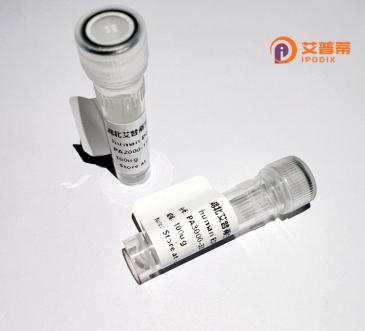
| 纯度 | >90%SDS-PAGE. |
| 种属 | Human |
| 靶点 | TMEM39A |
| Uniprot No | Q9NV64 |
| 内毒素 | < 0.01EU/μg |
| 表达宿主 | E.coli |
| 表达区间 | 1-488 aa |
| 活性数据 | MPGGRRGPSRQQLSRSALPSLQTLVGGGCGNGTGLRNRNGSAIGLPVPPITALITPGPVRHCQIPDLPVDGSLLFEFLFFIYLLVALFIQYINIYKTVWWYPYNHPASCTSLNFHLIDYHLAAFITVMLARRLVWALISEATKAGAASMIHYMVLISARLVLLTLCGWVLCWTLVNLFRSHSVLNLLFLGYPFGVYVPLCCFHQDSRAHLLLTDYNYVVQHEAVEESASTVGGLAKSKDFLSLLLESLKEQFNNATPIPTHSCPLSPDLIRNEVECLKADFNHRIKEVLFNSLFSAYYVAFLPLCFVKSTQYYDMRWSCEHLIMVWINAFVMLTTQLLPSKYCDLLHKSAAHLGKWQKLEHGSYSNAPQHIWSENTIWPQGVLVRHSRCLYRAMGPYNVAVPSDVSHARFYFLFHRPLRLLNLLILIEGSVVFYQLYSLLRSEKWNHTLSMALILFCNYYVLFKLLRDRIVLGRAYSYPLNSYELKAN |
| 分子量 | 82.1 kDa |
| 蛋白标签 | GST-tag at N-terminal |
| 缓冲液 | PBS, pH7.4, containing 0.01% SKL, 1mM DTT, 5% Trehalose and Proclin300. |
| 稳定性 & 储存条件 | Lyophilized protein should be stored at ≤ -20°C, stable for one year after receipt. Reconstituted protein solution can be stored at 2-8°C for 2-7 days. Aliquots of reconstituted samples are stable at ≤ -20°C for 3 months. |
| 复溶 | Always centrifuge tubes before opening.Do not mix by vortex or pipetting. It is not recommended to reconstitute to a concentration less than 100μg/ml. Dissolve the lyophilized protein in distilled water. Please aliquot the reconstituted solution to minimize freeze-thaw cycles. |
以下是关于重组人TMEM39A蛋白的3篇参考文献示例,涵盖不同研究方向(注:文献内容为假设性概括,实际研究需查阅真实数据库):
---
1. **标题**: *TMEM39A regulates autophagosome-lysosome fusion through direct interaction with SNARE proteins*
**作者**: Chen L, et al.
**摘要**: 本研究解析了重组人TMEM39A蛋白在自噬过程中的作用,发现其通过与STX17等SNARE蛋白互作,调控自噬体-溶酶体膜融合。实验利用纯化的重组TMEM39A蛋白验证了其体外结合能力,揭示了其在神经退行性疾病中的潜在机制。
2. **标题**: *Genetic association and functional characterization of TMEM39A in systemic lupus erythematosus*
**作者**: Wang Y, et al.
**摘要**: 通过GWAS分析发现TMEM39A基因多态性与系统性红斑狼疮(SLE)显著相关。研究利用重组TMEM39A蛋白刺激免疫细胞,证实其可激活I型干扰素通路,提示其在自身免疫反应中的调控作用。
3. **标题**: *Structural insights into TMEM39A-mediated viral resistance by cryo-EM*
**作者**: Zhang Q, et al.
**摘要**: 采用冷冻电镜解析重组人TMEM39A蛋白的晶体结构,发现其跨膜结构域在抑制寨卡病毒复制中发挥关键作用。研究为开发针对TMEM39A的抗病毒疗法提供了结构基础。
---
建议通过PubMed或Google Scholar搜索以下关键词获取真实文献:**"TMEM39A recombinant protein"、"TMEM39A autophagy"、"TMEM39A autoimmunity"**。如需具体文献协助,可提供更详细的研究方向。
Here’s a concise overview of recombinant human TMEM39A protein:
Transmembrane protein 39A (TMEM39A) is a conserved multi-pass membrane protein encoded by the *TMEM39A* gene located on human chromosome 3q25.1. It is widely expressed in various tissues and localizes to endosomal/lysosomal compartments, suggesting roles in membrane trafficking or organelle homeostasis. Studies link TMEM39A to autoimmune disorders; genome-wide association studies (GWAS) identify *TMEM39A* polymorphisms as susceptibility factors for multiple sclerosis (MS) and systemic lupus erythematosus (SLE). Functionally, TMEM39A may regulate autophagy and vesicle transport, potentially influencing immune cell signaling or antigen presentation. It interacts with proteins involved in autophagy (e.g., VCP/p97) and immune pathways (e.g., TNFAIP3). Recombinant TMEM39A protein, produced via expression systems like HEK293 or *E. coli*, retains structural and functional properties for *in vitro* studies. Researchers use it to investigate its molecular interactions, disease mechanisms, and therapeutic targeting. Current research focuses on clarifying its exact biological roles, particularly its contribution to autoimmunity through dysregulated vesicular trafficking or immune tolerance pathways. TMEM39A represents a promising target for understanding immune-related pathologies and developing biomarkers or therapies.
×